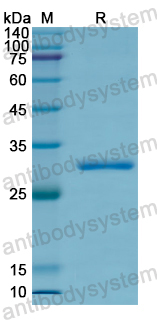Catalog No.
YHJ58801
Expression system
E. coli
Species
Homo sapiens (Human)
Protein length
Leu92-Glu346
Predicted molecular weight
30.96 kDa
Nature
Recombinant
Endotoxin level
Please contact with the lab for this information.
Purity
>90% as determined by SDS-PAGE.
Accession
Q9HB21
Applications
ELISA, Immunogen, SDS-PAGE, WB, Bioactivity testing in progress
Form
Lyophilized
Storage buffer
Lyophilized from a solution in PBS pH 7.4, 0.02% NLS, 1mM EDTA, 4% Trehalose, 1% Mannitol.
Reconstitution
Reconstitute in sterile water for a stock solution. A copy of datasheet will be provided with the products, please refer to it for details.
Shipping
In general, proteins are provided as lyophilized powder/frozen liquid. They are shipped out with dry ice/blue ice unless customers require otherwise.
Stability and Storage
Use a manual defrost freezer and avoid repeated freeze thaw cycles. Store at 2 to 8°C for frequent use. Store at -20 to -80°C for twelve months from the date of receipt.
Alternative Names
PH domain-containing family A member 1, Pleckstrin homology domain-containing family A member 1, Tandem PH domain-containing protein 1, TAPP-1, PLEKHA1, TAPP1
The potential crosstalk genes and molecular mechanisms between systemic lupus erythematosus and periodontitis., PMID:40309038
HDAC9-Mediated Pyroptosis Promotes Orthodontically Induced Inflammatory Root Resorption., PMID:40245750
Multi-omic quantitative trait loci link tandem repeat size variation to gene regulation in human brain., PMID:39809899
The Mechanism by Which Hedgehog Interacting Protein (HHIP) in Cancer-Associated Fibroblasts Regulate the Secretion of Inflammatory Factors Through the JAK1/STAT3 Pathway Affecting Prostate Cancer Stemness., PMID:39553307
Identification of JAZF1, KNOP1, and PLEKHA1 as causally associated genes and drug targets for Alzheimer's disease: a summary data-based Mendelian randomization study., PMID:39455528
EIF4G2 Promotes Hepatocellular Carcinoma Progression via IRES-dependent PLEKHA1 Translation Regulation., PMID:39213495
Identification of Genetic Variants for Risk Prediction and Early Diagnosis of Age-Related Macular Degeneration in the Taiwanese Population., PMID:38542204
Multiple-Pathway Synergy Alters Steroidogenesis and Spermatogenesis in Response to an Immunocastration Vaccine in Goat., PMID:38201210
Common gene signatures and molecular mechanisms of diabetic nephropathy and metabolic syndrome., PMID:37143982
10q26 - The enigma in age-related macular degeneration., PMID:36513584
De novo mutations within metabolism networks of amino acid/protein/energy in Chinese autistic children with intellectual disability., PMID:36320054
Genetic Overlap Analysis Identifies a Shared Etiology between Migraine and Headache with Type 2 Diabetes., PMID:36292730
Placental multi-omics integration identifies candidate functional genes for birthweight., PMID:35501330
Origin and Evolution of the Multifaceted Adherens Junction Component Plekha7., PMID:35399503
Characteristics of children diagnosed with type 1 diabetes before vs after 6 years of age in the TEDDY cohort study., PMID:34291312
Identification of PtdIns(3,4)P2 effectors in human platelets using quantitative proteomics., PMID:31743753
Rare Genetic Variants in Jewish Patients Suffering from Age-Related Macular Degeneration., PMID:31635417
Polymorphisms in Selected Genes and Their Association with Age-Related Macular Degeneration in a Chinese Population., PMID:29565837
Identification of non-HLA genes associated with development of islet autoimmunity and type 1 diabetes in the prospective TEDDY cohort., PMID:29310926
Specific correlation between the major chromosome 10q26 haplotype conferring risk for age-related macular degeneration and the expression of HTRA1., PMID:28659708
B-cell-intrinsic function of TAPP adaptors in controlling germinal center responses and autoantibody production in mice., PMID:27859053
Pax6 associates with H3K4-specific histone methyltransferases Mll1, Mll2, and Set1a and regulates H3K4 methylation at promoters and enhancers., PMID:27617035
Gene Structure of the 10q26 Locus: A Clue to Cracking the ARMS2/HTRA1 Riddle?, PMID:26427389
TAPP1 inhibits the differentiation of oligodendrocyte precursor cells via suppressing the Mek/Erk pathway., PMID:26242484
miR-21 is a negative modulator of T-cell activation., PMID:25304039
Study of Polymorphisms in CX3CR1, PLEKHA1 and VEGF genes as risk factors for age-related macular degeneration in Indian patients., PMID:25050486
Specificity and commonality of the phosphoinositide-binding proteome analyzed by quantitative mass spectrometry., PMID:24462288
Chromosome 10q26 locus and age-related macular degeneration: a progress update., PMID:24291204
Cumulative association between age-related macular degeneration and less studied genetic variants in PLEKHA1/ARMS2/HTRA1: a meta and gene-cluster analysis., PMID:24013816
Integration of genome-wide association studies with biological knowledge identifies six novel genes related to kidney function., PMID:22962313
Interaction of TAPP adapter proteins with phosphatidylinositol (3,4)-bisphosphate regulates B-cell activation and autoantibody production., PMID:22777911
Functional characterization of the pleckstrin homology domain of a cellulose synthase from the oomycete Saprolegnia monoica., PMID:22226909
Identification and characterization of splicing variants of PLEKHA5 (Plekha5) during brain development., PMID:22037487
Genetics of age-related macular degeneration: current concepts, future directions., PMID:21609220
A screen for novel phosphoinositide 3-kinase effector proteins., PMID:21263009
Role of TAPP1 and TAPP2 adaptor binding to PtdIns(3,4)P2 in regulating insulin sensitivity defined by knock-in analysis., PMID:21204784
Genome-wide association analyses of genetic, phenotypic, and environmental risks in the age-related eye disease study., PMID:21197116
[Genetic factors associated with age-related macular degeneration]., PMID:20510150
The roles of Dok family adapters in immunoreceptor signaling., PMID:19909370
Phosphoinositide 3-kinase-regulated adapters in lymphocyte activation., PMID:19909369
Distinguishing between smooth and rough free energy barriers in protein folding., PMID:19877713
ARMS2 is a constituent of the extracellular matrix providing a link between familial and sporadic age-related macular degenerations., PMID:19696174
[Genetic aspects of age-related macular degeneration]., PMID:19673454
A role for SNX5 in the regulation of macropinocytosis., PMID:18854019
[Update on the genetics of age-related macular degeneration]., PMID:18772819
Alleles in the HtrA serine peptidase 1 gene alter the risk of neovascular age-related macular degeneration., PMID:18164066
Review of genetics in age related macular degeneration., PMID:18097986
PLEKHA1-LOC387715-HTRA1 polymorphisms and exudative age-related macular degeneration in the French population., PMID:18079691
A variant of mitochondrial protein LOC387715/ARMS2, not HTRA1, is strongly associated with age-related macular degeneration., PMID:17884985
Emerging roles of phosphatidylinositol 3-monophosphate as a dynamic lipid second messenger., PMID:17178602

